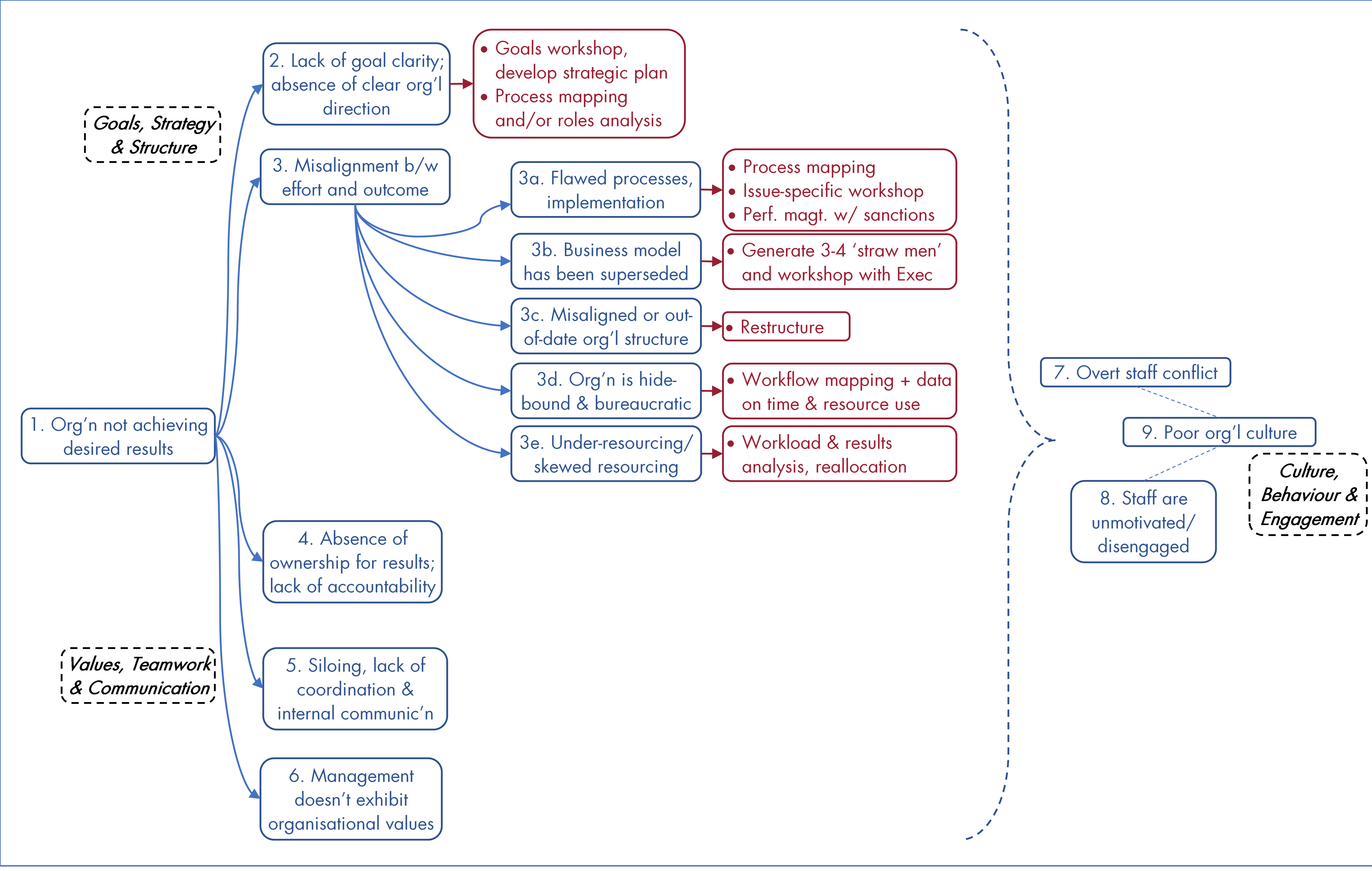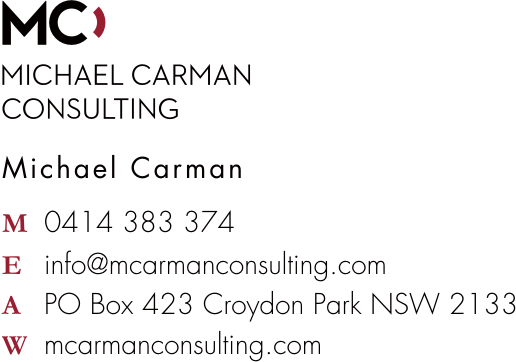Your 2020 Management Ready Reckoner - Part 2: Values, Teamwork & Communication
It seems eons ago, but earlier this year (2 February in fact) I published the first of a three-part series providing a ‘ready reckoner’ for key management issues. That newsletter, which you can read here, outlined problems and solutions relating to Strategy, Structure and Resourcing.
(The newsletter I sent in the intervening period – in May – providing Three Quick Thoughts on Coronavirus can be found here).
Recall that we considered an organisation not achieving the results it would like to; and this could be due to lack of goal clarity, absence of clear direction, or misalignment between effort and outcome – the problems we dealt with in February:

In this newsletter we look at organisational shortcomings that are due to:
- People not taking ownership for results, and a general lack of accountability
- Siloing, and a lack of coordination or internal communication, and
- Management not exhibiting the values they expect of others.
These Values, Teamwork and Communication Issues are represented in the diagram above by bubbles 4, 5 and 6.
Assuming that the problems have been correctly diagnosed, how would we go about addressing these shortcomings? I’ve added my recommended solutions for dealing with the problems, shown in the diagram below: problems are in blue, solutions in red.

Establishing Accountability and Ownership for Results
To deal with issues of accountability or ownership for results (item 4) in the first instance I recommend establishing a performance management system in which business plan goals are cascaded through divisions and units, and accountabilities reflected accordingly in individual performance development plans. Each staff member should regularly (ideally, quarterly) review performance against their plan with their manager. Such a performance management system (which, to be clear, encompasses not just plans, but reviews and active follow-up) is the cornerstone and principal mechanism for accountability and clarity regarding ownership of results.
Where accountabilities or results-ownership are muddied because a manager takes on all responsibilities (“It’s just easier if I do it myself!”) training in delegation and skills for new managers can yield great value. This issue can be a particular challenge for those who have recently been promoted to the ranks of management and who need to make the adjustment from being a capable team member applying their expertise, to overseeing a team of people providing their expertise. I’ve delivered this kind of L&D to new managers in a variety of contexts, to good effect: it has helped get participants used to the idea of overseeing a team, and to hold back from diving in and micro-managing.
Another possible reason why staff don’t take ownership for results could be that their existing work profile is unsatisfying and undemanding. In this case, job redesign (or, better, to use Herzberg’s term: job enrichment) may be in order. This entails redesigning a role to give it greater challenge and responsibility, and hence improving the prospects of the person in that role engaging with their work.
Breaking Down Silos; Enhancing Coordination and Communications
To address siloing and blocked information flows across units (item 5) I recommend a collaborative process mapping exercise, undertaken from the perspective of the customer/ stakeholder. Of particular use is process mapping undertaken using swim lanes, to highlight hand-offs between units.
Note the emphasis on the use of collaborative mapping: it’s one thing for an individual to sit at their computer and draft a process map encompassing a number of divisions; it’s another entirely for a workshop of people with representatives from all relevant divisions to map a process together. The latter has two benefits: firstly, areas of contention are likely to surface earlier and so can be dealt with sooner … and collectively. Secondly, the more divisions that participate, the more are likely to ‘sign on’ to the process as mapped (and the solutions to any grey areas or points of contention) so enhancing the prospects for smooth operational and informational flows. Which is, of course, the point of the exercise.
Once mapped, policies and procedures should be developed and implemented so that the agreed cross-functional accountabilities can be captured and referred to. These policies and procedures should include the process maps and swim-lane flow charts.
Leading by Example
Management not exhibiting the organisational values it seeks from staff (item 6) is one of the most serious, and damaging, issues an organisation has to face. If senior management flouts stated organisational values (which latter invariably appear in sundry organisational products such as corporate plans, annual reports, screen savers and coffee mugs) the values won’t only be ignored; they will be held in contempt. And, worse, staff will have licence to flout the values they’ve been told to exhibit … and the organisation will lose internal (and subsequently, external) credibility.
One prominent financial institution (thankfully not a client of your correspondent) invited two of its executive leadership team to address a large forum of the organisation’s middle managers. The executives took to taking pot-shots at one another. What message did that convey to the assembled masses? Oh, and two of the institution’s values are Integrity and Collaboration. Good luck with that – let me know how that’s working out for you.
Experience trounces rhetoric every time: people believe what they see, not what they read. Executive coaching and leadership training may be of use here, although note that these can help change behaviours … but not character. That will be all that can be hoped-for, but it may be enough. Leadership L&D run as an immersive experience using role plays and simulation are particularly effective for surfacing issues and generating in situ insights and strategies. They also allow interpersonal techniques to be ‘tried out’ in a safe and fun environment. The performance management system noted above (in 'Establishing Accountability and Ownership for Results') provides a mechanism to discuss (and, if needed, to address) how congruent or otherwise an executive's conduct has been with the organisation's values.
* * *
A quick note on workshops and Covid-19
Can you still run workshops and L&D in the age of Covid?
Yes, you can. While working from home and social distancing impact what can be done – and how – workshops and immersive L&D experiences can still be run. Video-conferencing, Zoom, and Microsoft Teams all enable remote participation in collaborative efforts and hence virtual workshops can be carried out. Face-to-face events can also be held with proper social distancing observed (albeit not in Victoria at present) and, if the participant count is too high for a single workshop, one workshop can be split into multiple events, with work undertaken out of session to pull material together.
The point is that workshops and L&D sessions can still be safely undertaken, including in modified form. A workshop is, of course, a means to the ends of enhanced collaboration, higher morale, and effective joint decision-making … and the need for these is as pressing as ever in the current environment: circumstances don’t have to prevent you from accessing the collaborative clarity and joint purpose you need at the time you need it most!
* * *
I hope this ready reckoner of values, teamwork and communication solutions is useful. Next newsletter I will outline my recommended solutions in the areas of Culture, Behaviour and Engagement.
In the meantime, stay safe and well.
Michael

© Michael Carman 2020
